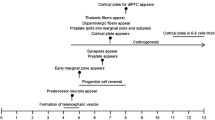Abstract
Neurophysiological, neuropsychological, neuroanatomical, and neuroradiological findings in schizophrenic psychoses demonstrate that subcortical (e.g., mesolimbic and diencephalic regions) as well as neocortical structures (e.g., dorsolateral prefrontal cortex, superior temporal and inferior parietal cortices) are involved. Special significance is accorded to the neuroanatomical connection between limbic structures and the dorsolateral prefrontal cortex. Here myelinization begins relatively late in humans, during the second and third decade of life—a particularly vulnerable period for schizophrenic onset. The nature of prepsychotic behavioral abnormalities in patients with early-onset schizophrenia as well as the existence of typical cognitive dysfunctions preceding the manifestation of psychotic symptoms points to the importance of a dynamic imbalance of neocortical-subcortical interactions in the etiology of schizophrenia. Based on the crucial importance of the prefrontal-hippocampal circuitry a stimulus barrier model of schizophrenic psychoses is elaborated, which integrates recent neurobiological findings as well as results of research in modern developmental psychology. One of the implications of this model is the multidimensional treatment of schizophrenic patients.
Similar content being viewed by others
References
Akbarian S, Bunney WE, Potkin SG, Wigal SB, Hagman JO, Sandman CA, Jones EG (1993) Altered distribution of nicotinamide-adenine dinucleotide phosphatediaphorase cells in frontal lobe of schizophrenic implies disturbances of cortical development. Arch Gen Psychiatry 50: 169–177
Arnold SE, Franz BR, Gur RC, Gur RE, Shapiro RM, Moberg PJ, Trojanowski JQ (1995) Smaller neuron size in schizophrenia in hippocampal subfields that mediate cortical-hippocampal interactions. Am J Psychiatry 152: 738–749
Asarnow RF, Brown W, Strandburg R (1995) Children with a schizophrenic disorder: neurobehavioural studies. Eur Arch Psychiatry Clin Neurosci 245: 70–79
Asarnow RF, Asamen J, Granholm E, Sherman T, Watkins JM, Williams ME (1994) Cognitive/neuropsychological studies of children with a schizophrenic disorder. Schizophr Bull 20: 647–669
Benes FM, Sorensen I, Bird ED (1991) Reduced neuronal size in posterior hippocampus of schizophrenic patients. Schizophr Bull 17: 597–608
Bickerdike MJ, Wright IK, Marsden CA (1993) Social isolation attenuates rat forebrain 5-HT release induced by KCI stimulation and exposure to novel environment. Behav Pharmacol 4: 231–236
Bock J, Wolf A, Braun K (1996) Influence of the N-methyl-D-aspartate receptor antagonist DL-2-amino-5-phosphono valeric acid on auditory filial imprinting in the domestic chick. Neurobiol Learn Mem 65: 177–188
Braun K (1996) Synaptische Reorganisation bei frühkindlichen Erfahrungs- und Lernprozessen: Relevanz für die Entstehung psychischer Erkrankungen. Z Klin Psychol Psychiatr Psychotherap 44: 253–266
Csernansky G, Bardgett M (1998) Limbiccortical neuronal damage and the pathophysiologoy of schizophrenia. Schizophr Bull 24: 231–248
Eggers Ch, Bunk D, Krause D (1998) The long-term course of early onset schizophrenia. Neurol Psychiat Brain Res 6: 29–36
Eggers Ch, Bunk D (1997) The long-term course of childhood-onset schizophrenia: a 42-year follow-up. Schizophr Bull 23: 105–117
Fonagy P (1996) Fortschritte in der Psychoanalytischen Technik mit jugendlichen Borderline-Patienten. Zeitschrift der Wiener psychoanalytischen Vereinigung 7: 11–37
Frazier JA, Giedd JN, Hamburger SD, Albus KE, Kaysen D, Vaituzis AC, Rajapakse JC, Lenane M, McKenna K, Jacobsen LK, Gordon CT, Breier A, Rapoport JL (1996) Brain anatomic magnetic resonance imaging in childhood-onset schizophrenia. Arch Gen Psychiatry 53: 617–624
Gruss M, Braun K (1996) Stimulus evoked glutamate in the medio-rostral neostriatum/ hyperstriatum ventrale of domestic chick after auditory filial imprinting: an in vivo microdialysis study. J Neurochem 66: 1167–1173
Jakob H, Beckmann H (1986) Prenatal development disturbances in the limbic allocortex in schizophrenics. J Neural Tansm 65: 303–326
Jones P, Rodgers B, Murray R, Marmot M (1994) Child developmental risk factors for adult schizophrenia in the British 1946 birth cohort. Lancet 344: 1398–1402
Köhler L (1992) Formen und Folgen früher Bindungserfahrungen. Forum Psychoanal 8: 263–280
Newman KM (1996) Winnicott goes to the movies: the false self in ordinary people. Psychoanal Q 65: 787–807
Oades RD, Zerbin D, Dittman-Balcar A, Eggers Ch (1996) The topography of event-related potentials and four subtraction waves in a three-tone auditory discrimination: young healthy adults and patients with obsessive-compulsive disorder, paranoid and non-paranoid psychosis. Int J Psychophysiology 22: 185–214
Okubo Y, Suhara T, Suzuki K, Kobayashi K, Inoue O, Terasaki O, Someya Y, Sassa T, Sudo Y, Matsushima E, Iyo M, Tateno Y, Toru M (1997) Decreased prefrontal dopamine D1 receptors in schizophrenia revealed by PET. Nature 385: 634–636
Rapoport J, Giedd J, Kumra S, Jacobsen L, Smith A, Lee P, Nelson J, Hamburger S (1997) Childhood-onset schizophrenia. Progressive ventricular change during adolescence. Arch Gen Psychiatry 54: 897–903
Thome J, Foley P, Riederer P (1998) Neurotrophic factors and the maldevelopmental hypothesis of schizophrenic psychoses. J Neural Transm 105: 85–100
Weinberger DR, Berman KF, Suddath R, Torrey EF (1992) Evidence of dysfunction of a prefrontal-limbic network in schizophrenia: a magnetic resonance and regional cerebral blood flow study of discordant monozygotic twins. Am J Psychiatry 149: 890–897
Werry JS, McClellan JM, Andrews LK, Ham M (1994) Clinical features and out-come of child and adolescent schizophrenia. Schizophr Bull 20: 619–630
Winnicott DW (1956) Primary maternal preoccupation. In: Collected Papers: Through Paediatrics to Psycho-Analysis. New York: Basic Books, 1958, pp 300–305
Author information
Authors and Affiliations
Rights and permissions
About this article
Cite this article
Eggers, C. Some remarks on etiological aspects of early-onset schizophrenia. European Child & Adolescent Psychiatry 8 (Suppl 1), S1–S4 (1999). https://doi.org/10.1007/PL00010683
Issue Date:
DOI: https://doi.org/10.1007/PL00010683



